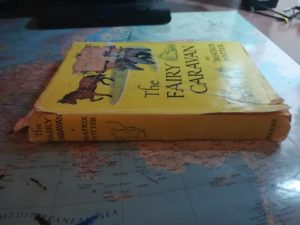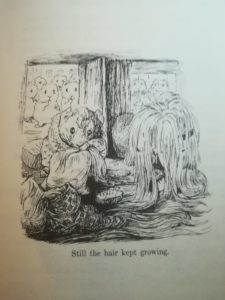Books were an enormous part of my childhood, but there’s one that stands out in my memory. The author is well-known, but the story itself is much less famous. The Fairy Caravan is a full-length novel aimed at older children, written and illustrated by Beatrix Potter, who is much better known for stories such as Peter Rabbit and Jemima Puddleduck.
While I loved all of Potter’s stories, The Fairy Caravan was special. I remember being read a chapter a night by my grandpa during stays at my grandparents’ house – he was always the best at doing the voices. When I was old enough to read longish books by myself, I read The Fairy Caravan cover to cover, again and again. As you can see from the pictures, my copy has that falling-apart look that a book can only achieve when it’s been truly loved.

The Fairy Caravan tells the story of a travelling circus, which is, like all of Beatrix Potter’s stories, made up of anthropomorphic animals who can definitely be read as a microcosm of rural English society. Potter was a dedicated farmer and a champion of protecting rural life and small farms in the Lake District, and her love of this particular part of Britain always comes through in her stories. The animals who make up the travelling circus visit many different farms, crofts and villages to perform their shows, meeting a whole host of colourful characters along the way.
 While The Fairy Caravan is a story with many different characters, and really reads more like a collection of short stories linked together than a traditional novel, there’s one character who I always saw as the hero – the hapless guinea pig Tuppenny. The story begins with Tuppenny, always a little ill and quite scruffy-looking, being given a hair-growing treatment by his family to help his coat get thicker. Unfortunately, the treatment is a bit too effective, and Tuppenny ends up looking more like Cousin It than any of the other guinea pigs in his town. Ashamed of his new and unusual appearance, Tuppenny runs away and joins the circus, finding new friends, broadening his horizons, and learning about the wider world around him.
While The Fairy Caravan is a story with many different characters, and really reads more like a collection of short stories linked together than a traditional novel, there’s one character who I always saw as the hero – the hapless guinea pig Tuppenny. The story begins with Tuppenny, always a little ill and quite scruffy-looking, being given a hair-growing treatment by his family to help his coat get thicker. Unfortunately, the treatment is a bit too effective, and Tuppenny ends up looking more like Cousin It than any of the other guinea pigs in his town. Ashamed of his new and unusual appearance, Tuppenny runs away and joins the circus, finding new friends, broadening his horizons, and learning about the wider world around him.
Beatrix Potter’s stories have always had a magical edge, featuring a world of talking, clothed animals that steal from farmers or help out sickly tailors, but The Fairy Caravan is where her work truly tips over into fantasy, finishing up with a story about actual fairies that inhabit the forests and mountainsides of the Lake District. The fairies appear in a chapter that hammers home the real theme of the story – the protection of these natural, wild spaces from industrialisation, a message that Potter carried forward in the conservation work to which she devoted the later part of her life. The Fairy Caravan is, more than anything else, a celebration of the countryside and the creatures that inhabit it, and a reminder to all humans to tread softly and do as little harm to the natural world as we possibly can.
The Fairy Caravan and Beatrix Potter’s other books are single-handedly responsible not only for my love of the Lake District (one of the most beautiful places in the UK), but of books and reading itself. Reading this book made me want to be an author, a dream that hasn’t wavered in the thirty years since I first realised that, hey, books had to actually be written by someone. And it has one of the best opening lines I’ve ever read – ‘In the Land of Green Ginger there is a town called Marmalade, which is inhabited exclusively by guinea pigs’. If you’re looking for a new bedtime story to read to your child or your nibling. The Fairy Caravan is a magical choice.
If you want to know a little more about Beatrix Potter herself, Happy Birthday, Beatrix Potter has some brilliant suggestions. If you’re looking for a slightly different take on Potter’s most famous book, try An Absolutely Serious Analysis of The Tale of Peter Rabbit.













